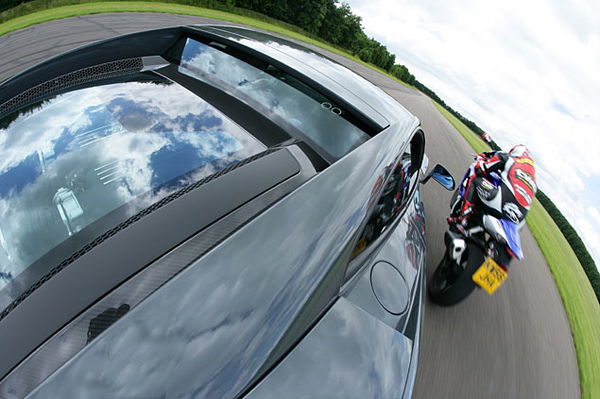The GSX-R Factor
GSX-R. No other machine has had the impact on motorcycling in the last 30 years than those four letters have. But what has made the GSX-R so great?

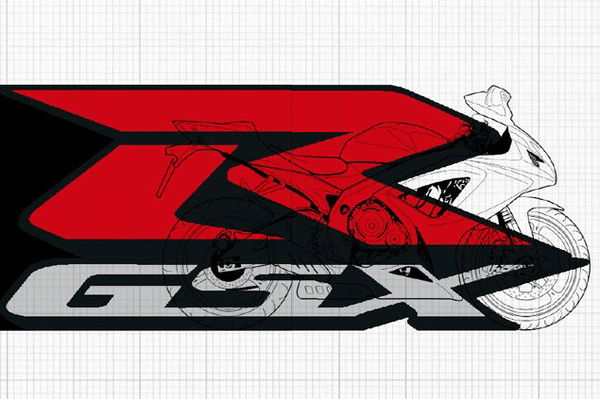
�
It’s the bike that’s launched a thousand race careers. It single-handedly began the sportsbike revolution that we know and love. It gave us Schwantz, Slingshot carbs, the streetfighter sub-culture and gaudy shell-suit graphics. It gave us a million different suspension variations when we didn’t need them. It scared us senseless with top-heavy wibbly-wobbly handling all rounded off with flexible wheels and spindly forks, then it began the track-day phenomenon we all enjoy today. It also made the 750 the sexiest capacity of sportsbike.
And to top it all off it gave us a multitude of bizarre and confusing acronyms such as SRAD, SACS, SCAI, SCEM, SOL-AIR, DAIS, DIAS, PDF, DOP, NEAS, MR-ALBOX and TSCC (Do you know them all? Answers on the last page).
But only four letters really matter – and they are GSX-R. Those letters have given us some truly seminal powerplants, in 250, 400, 600, 750, 1000 and 1100cc formats. In short, it’s given us more than two decades of paddock-jacketed lunacy, crammed full of double-cradle craziness and for that we should be thankful. But that’s not all.
Click next for more
conceived on the Ryuyo circuit
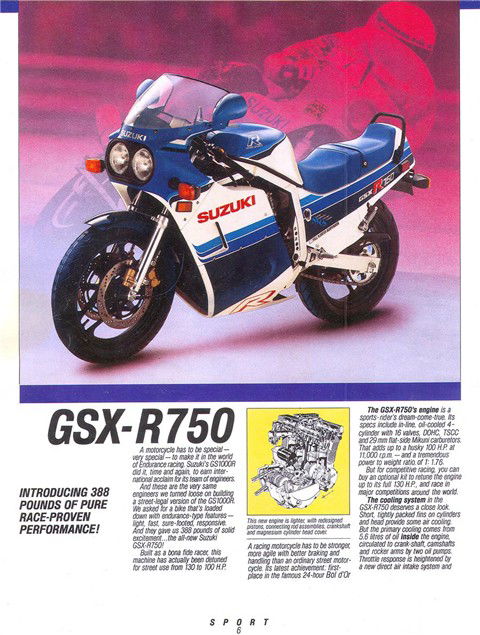
�
The Suzuki GSX-R family is over a quarter of a century old, marking 25 years since the launch of the GSX-R400 in Japan and without it and its much more famous ‘big brother’ the 750, we wouldn’t be where we are today. It’s true to say that the GSX-R phenomenon has come to define what a sportsbike is. Indeed, GSX-R could be a generic term for a sportsbike, conjuring as it does the image of speed, power, performance and race-track heritage. And best of all, for an affordable price. It is one of the most momentous monikers in motorcycling and without it, you wouldn’t have your Fireblades, R1s or the latest collective noun of Ninjas. The GSX-R is the only motorcycle that can truly lay claim to being the father of the sportsbike as we know it today.
So here, we’re not going to chronologically run out the facts of what GSX-R came out when, or what VIN numbers the rare SP GSX-R750RRK from 1989 carried. This story isn’t for pedants, it’s for those with passion. Passion for sportsbikes and GSX-Rs in particular. So we’ve asked those inextricably linked with its 24-years in existence to tell us what truly has made the GSX-R great. But first let’s set the scene.
It’s the late 1970s and road bikes in general tend to be unfaired and mostly shit. In racing two-strokes rule in GPs, but for the Japanese factories endurance racing is also very important. In this class, Honda is dominating, but soon both Kawasaki and Suzuki will topple them as endurance World Champions. By 1981 rumours began to circulate about a new racer from Suzuki, equipped with an (un-heard of at the time) alloy frame and a 997cc four-stroke motor.
The rumours continue that it had hit an amazing 175mph at Suzuki’s Ryuyo test track. This was the GS1000R or XR41, and this was the father of the GSX-R. It won the world endurance title in 1983 and with endurance rules changing to 750cc for 1984, Suzuki could see that there was plenty of mileage in a production machine infused with the DNA of the XR41. Endurance racing then, gave the GSX-R its unique look. That double-headlamp glare and the skinny rear flanks. Change as it has over the years, the GSX-R can still be easily identified as such. Suzuki exploited this heritage for the first brochure shot – the 750F in the foreground and the XR41 just behind it. The family resemblance was obvious.
Click next for more
in the hands of Schwantz
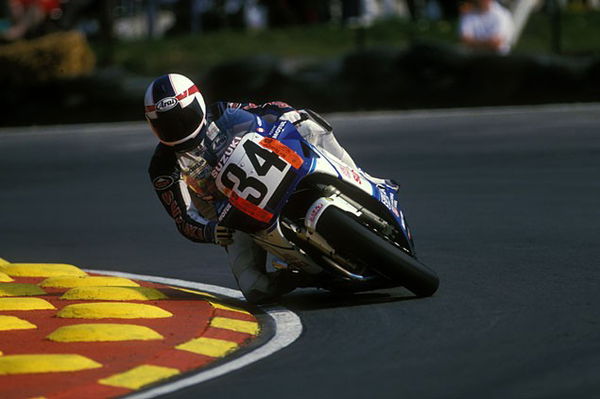
�
Roger Simmonds was head mechanic at Suzuki GB for many years and has an intimate relationship with the GSX-R, having stripped more down than he cares to remember, as well as being a development rider from 1987 onwards.
He remembers when the crate containing the very first GSX-R750F landed in the UK. “When we opened that first crate we were astounded by what we saw and very excited. Back then Suzuki GB was run by enthusiastic bike riders, and from the start the management decreed that only priority mags got the bikes as the management wanted to ride the bikes themselves! What people also forget is that before the GSX-R we never had any track days, but we started that after the 750 launch. We took it to Mallory and Oulton. The track day craze you have now stems from back then.”
Before his glory days in 500cc GPs, Kevin Schwantz’s name was inextricably linked with the GSX-R and legendary tuning firm Yoshimura. He still remembers today what a visual smack in the face the original slab-sided GSX-R750F was back in 1985. He says: “I was riding the GS700* in 1985 as we in the States got the GSX-R750F a year later than you guys in Europe. When I first saw it I thought ‘shit man, that’s like a race bike already!’ Of course it was developed from the endurance machines but the look alone told you all you needed to know about where it was aimed.”
Launched at the Cologne show in 1984, the original GSX-R750 was unveiled alongside the five-valve per cylinder Yamaha FZ750, Honda NS400R two-stroke triple, Kawasaki GPZ600R and Suzuki’s two-stroke RG500. The GSX-R has outlived all of them and later spawned a host of imitators, which again it has outlived.
* The Suzuki GSX750 in Europe was the GSX700 in the USA with 50cc lopped off for racing.
Click next for more
Roland rode
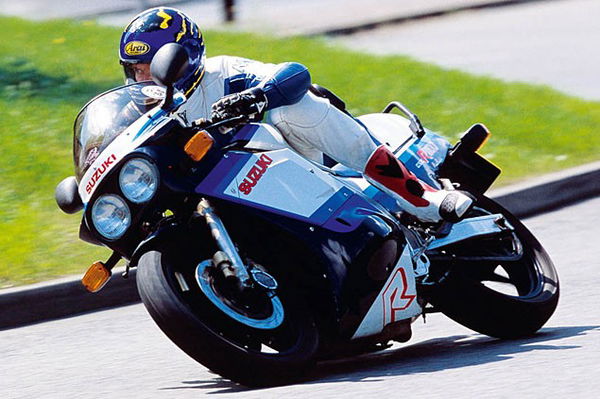
�
Over the intervening years Kawasaki launched the ZXR750 and RC30 and Yamaha the OW-01 and then the YZF750. Each came with a fairing and lesser or greater degrees of sporting promise, but the GSX-R was the first. It also did something that two machines in the list above did not – it provided real value for money.
To go World Superbike racing Honda and Yamaha made two über expensive race-bikes for the road in the RC30 and OW-01. But Suzuki stuck to its guns, making the GSX-R series affordable. If ever a manufacturer gave real ‘power to the people’ then it’s Suzuki with the GSX-R. Value for money has always been a GSX-R trait, according to journalist Roland Brown, who has ridden every incarnation of the series over the last 20 years.
Few know the GSX-R as well as him. “For me that’s the real beauty of the GSX-R: it didn’t cost any more than the other 750s, but you could race it – this is in comparison to the likes of the OW-01 and RC30 which were double the price. I owned one of the first 750Fs in the country. Suzuki put together a race series and I rode in that. I maintain to this day that it’s the best bike I’ve ever owned or raced. Virtually standard it was quicker than an F1 race bike and these had Harris frames and trick motors tuned to the heavens. Remember, before the GSX-R alloy-framed supersports bikes equipped with flexible wheels, no centre-stand and with weak gearboxes didn’t exist: Although soon everybody would get on the bandwagon. Imitation is the sincerest form of flattery, after all.” By the early 1990s the GSX-R was beset on all sides by the competition.
Click next for more
success on the track
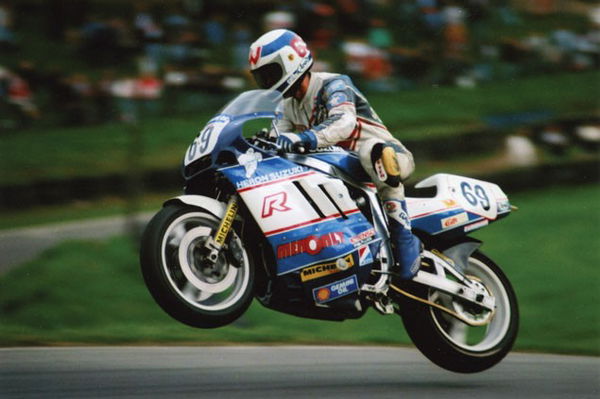
�
It proved to be harder and harder to improve on the original recipe. The first GSX-R was far from being just another streetbike, it had invented the term ‘race replica’ and had introduced a new word and definition into the lexicon of motorcycling. The engineers on the original GSX-R750 called the concept ‘Born on the circuit, back to the circuit’ but subsequent machines forgot this. Soon the GSX-R retreated Elvis-like into its own two-wheeled Graceland, gorging itself until it was a lardy pastiche of itself. Then, to add insult to injury, the Japanese committed visual Hara-Kiri by dressing the GSX-R in the worst paint-schemes ever.
Despite the addition of water-cooling with the 750WN of 1992 and the 1100WP of 1993, the GSX-R was past it, chronically short of breath thanks to the double-cradle frame, which restricted how the engine could breath via the airbox and how it handled, with its weight high up in the frame.
The ultimate irony was that Suzuki’s persistence with the frame design and the old oil/air-cooled motor as well as a switch to a short-stroke design with the 750J of 1988 meant that Suzuki were going a few steps forward and then a few more back while the opposition surged ahead. Like a middle-aged man in a shell suit, the GSX-R range was not the cutting-edge, svelte machine it once was. It was – quite frankly – time for the GSX-R to die.
James Whitham has had a long career with the Suzuki GSX-R – winning the 1988 British Production title on a 750J and the 1991 MCN TTF1 series and although he has fond memories of many GSX-Rs, the 1992 WN is summed up by the man himself: “It was made out to be the business, more power etc, but it was so long we called it ‘the ironing board’. It was a piece of shit to be honest.”
Click next for more
Grand Prix inspiration
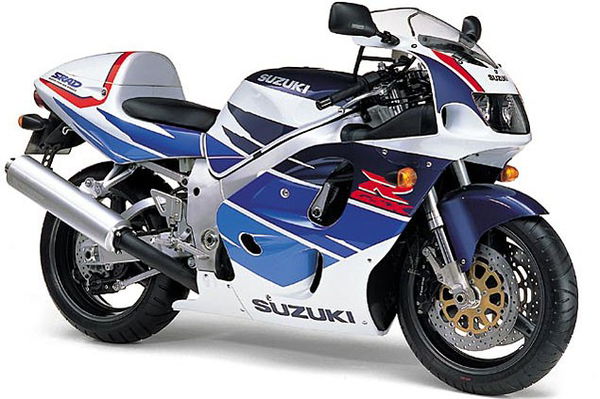
�
That’s not to say that the GSX-R wasn’t still innovating in its own way. Roger Simmonds adds: “I think the oil/air-cooled models still did well, until the bike became lardy with the water-cooled model. And remember that the GSX-R started this whole trend and even in the early 1990s it was still value for money and had a bad boy image – it still does. It innovated still, too, with the likes of upside-down front forks on the 750L – which I think were a first back in 1990 – and the 1100 was arguably the first bike to get six-pot brake calipers. And don’t forget those engines. All through the GSX-R’s life the motor has literally been at the heart of the bike and has always been competitive on power, if not at the very top. Suzuki’s GSX-R1100 motor has to be one of the best engines ever made.”
But it had still been left behind. Luckily for us the series wasn’t killed off, because at Suzuki the GSX-R had become a living, breathing organism and there was a new crowd of engineers in town who wanted to take the GSX-R back to basics. On April 8th 1993 they met in a room in the Suzuki Motor Corporation HQ in Hamamatsu and decided to come up with a new breed of GSX-R, basing the geometry on Schwantz’s Championship winning RGV500 of that year.
Haruo Terado was the group leader of the project. He says: “Heritage was very important, but with new models launched from other manufacturers, we had to create a new generation of GSX-R. We decided that the best way to achieve high performance was to combine Kevin’s 1993 factory RGV with a light-weight, compact four-stroke 750. ‘Light weight’ ‘fast’ and ‘easy-to-use’ were our goals. With the 1996 GSX-R we gave our engineers the basic idea of the RGV500, a target weight of 179kilos and a power-to-weight ratio of 1.398 kilos per horsepower. Everything else we left to them.”
Unsurprisingly the double-cradle frame disappeared, replaced by a sturdy beam-frame, while the appearance of twin-scoops either side of the trademark twin-spot GSX-R stare came courtesy of the Suzuki Ram Air Direct system, which boosted power at high speed. It was the birth of another hooligan machine and the GSX-R was back on top once more, taking the fight to the likes of the bigger FireBlade.
Click next for more
move to 1000cc
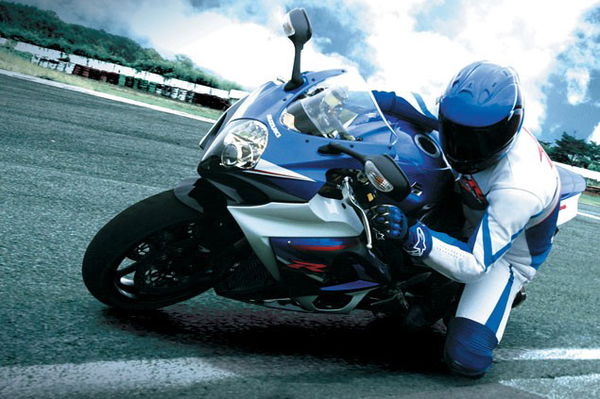
�
Since then the 750 has almost become secondary to the whole GSX-R story, as from 2001 the GSX-R1000 was born, more out of necessity as 1000cc became the capacity of choice.
But still Suzuki has stuck resolutely with the 750 formula, building successive GSX-R750s. But while the GSX-R750 sits in a class of one, many still rate it, even against more powerful opposition. It continues to impress and sell, raising the question that why doesn’t Honda, Yamaha or Kawasaki make a 750? Maybe that would be like Ferrari making a Porsche. Roger Simmonds: “I think it’s a classic, like a Porsche 911: Constantly changing and evolving, but there’s never an age limit on it. When I was at Suzuki, the GSX-R and the 750 in particular was one of the most prestigious models for the designers to work on.”
Hiroshi Iio was one of those designers. The 53-year-old joined Suzuki back in 1979 where his first job was working on the engine of the GSX1100. For many years he has been the head of Supersport development for Suzuki as well as heading up the design of a number of GSX-R variants.
“Performance has always been the first requirement of a GSX-R,” he says. “We want the best handling and braking machine and one that has the most powerful or best performing engine. This is what drives us with the GSX-R family. Secondly, it has to look like a GSX-R, despite the many aerodynamic concerns placed on the design of the bike. It terms of which GSX-R is the most important I would say ‘all of them’ but sales-wise the 600 is the most important, even though for me my most favourite bike ever is the very first GSX-R750F. I think the reason why we have stayed faithful with the 750 is that we have a long history with it. Sales show it is still wanted by the people.”
In closing this piece on this wonderful, seminal family of motorcycles, I leave it to Roland Brown to sum-up. “If the modern motorcycling era began in 1969 with the Honda CB750 with disc brakes and electric start then sportsbikes began with the Suzuki GSX-R750F of 1985. That makes it the second most influential bike of the last century.”
Click next for more
GSX-R acronyms

�
Did you remember your GSX-R acronyms correctly?
- SRAD – Suzuki Ram Air Direct
- SACS – Suzuki Advanced Cooling System
- SCAI – Suzuki Cool Air Induction
- SCEM – Suzuki Composite Electrochemical Material
- SOL-AIR – Suzuki Oil-Cooler Airflow Control
- DAIS – Direct Air Intake System
- DIAS – Digital Ignition Advance System
- PDF – Positive Damping Fork
- DOP – Dual Opposed Piston
- NEAS – New Electrically Activated Suspension
- MR-ALBOX – Multi-Rib Aluminium Alloy Box-section
- TSCC – Twin Swirl Combustion Chamber
Model Evolution
From 750 to 1100 then back to 750 again via a brief 400 before settling on 600, 750 and 1000. Here are the truly seminal GSX-Rs that have helped form the brand we know today.
- 1985 - GSX-R750 F
- 1986 - GSX-R1100 G
- 1989 - GSX-R750 J
- 1991 - GSX-R1100 M
- 1993 - GSX-R400 RR
- 1995 - GSX-R1100 P
- 1996 - GSX-R750 SRAD
- 1997 - GSX-R600
- 2001 - GSX-R1000 K1
- 2005 - GSX-R1000 K5
- 2008 - GSX-R600
Which GSX-R did you own and what are memories of it?
